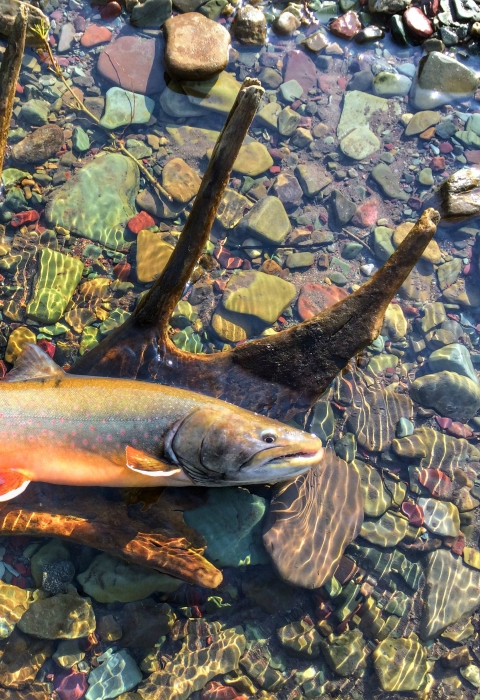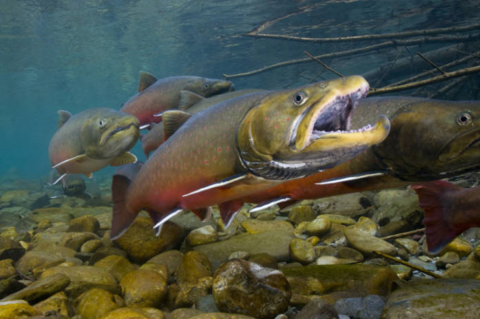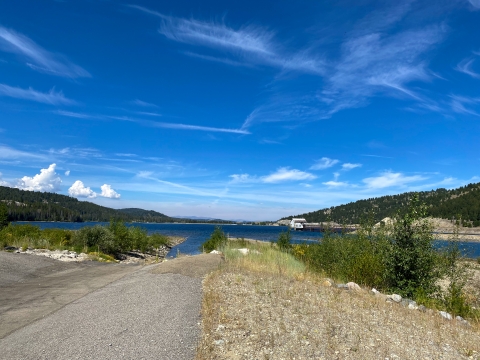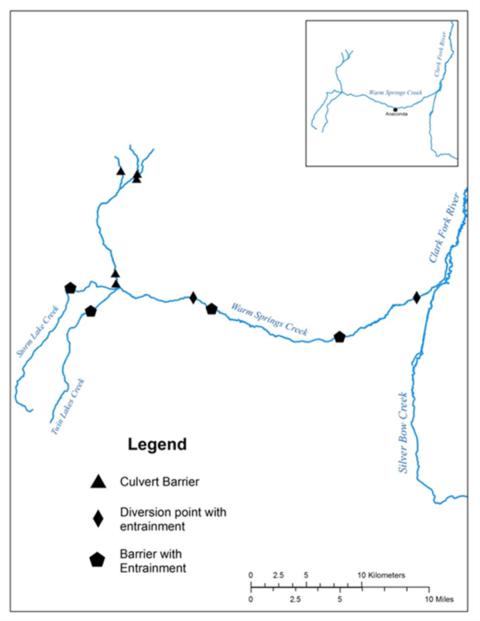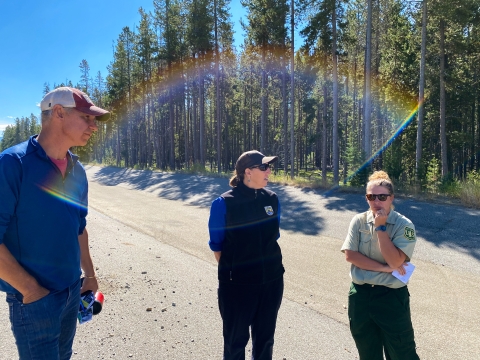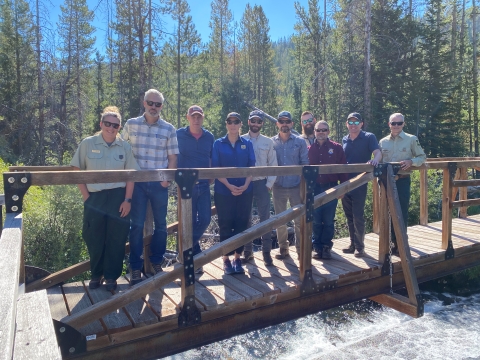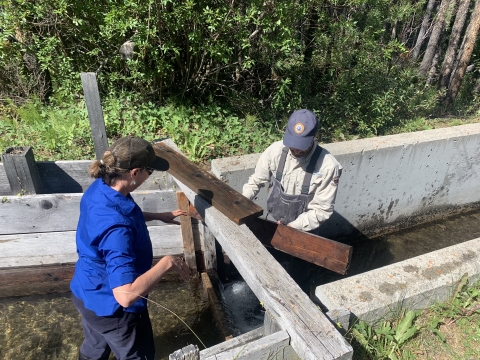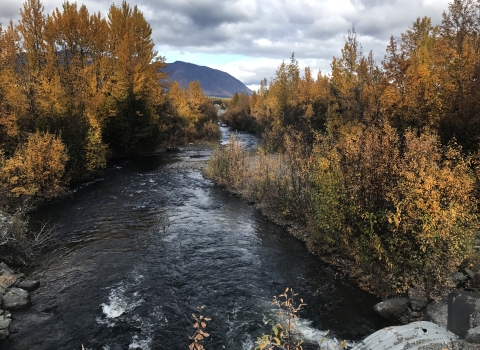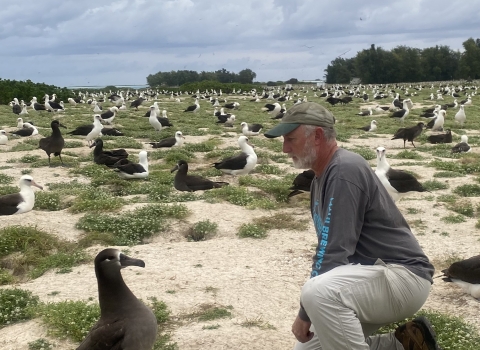When you look at a bull trout, you might just see a fish, but there is a bigger story at play. Its evolution, lifecycle, and relationship with the changing world underscore a much richer meaning of what this curious fish represents.
Bull trout are large fish that are a little rarer on the landscape. They are vulnerable to climate change climate change
Climate change includes both global warming driven by human-induced emissions of greenhouse gases and the resulting large-scale shifts in weather patterns. Though there have been previous periods of climatic change, since the mid-20th century humans have had an unprecedented impact on Earth's climate system and caused change on a global scale.
Learn more about climate change and therefore become a pretty good indicator for watershed health.
This fish relies on cold, clean, complex, and connected water flows to survive. A migratory fish, bull trout travel across waterways throughout various life stages to reproduce, feed, and recycle nutrients throughout the landscape. Some bull trout will even make the journey from freshwater to ocean and back demonstrating how the ability to move is an important part of this olive-colored fish’s life.
It Takes Partnership to Restore a River
Knowing where to start with understanding fish migration can be challenging. A scientific study helped shed light on this question by utilizing chemical analysis on otoliths (fish ear bones) to trace fish to their origin points.
This study revealed that the waterways in southwest Montana are especially significant for bull trout by creating cold water oases that help fish hide from the heat. Further assessments of the area discovered sections of the river that are critical for fish migrating to their spawning grounds.
This watershed is the furthest upstream population in the Clark Fork River and Warm Springs is the headwater of the river, which means there are very cold waters coming out of the mountains that allow bull trout to persist. This foundation helped spur the importance of undertaking a project in the area to support bull trout.
Partnership proved critical in this endeavor.
Representatives from federal and state agencies, local government, NGO's and more coalesced together to improve the Upper Clark Fork Rivers connectivity for bull trout and other fish. “We are doing this for native species and most importantly for enhancing bull trout habitat and connectivity to protect the uppermost population of bull trout in the Clark Fork River system,” emphasized Cameron Rasor, District Ranger with the U.S. Forest Service. The multi-year initiative has been steadily chipping away at reinvigorating the river.
In 2021, the Upper Clark Fork Fish Passage Initiative project received $230,000 from the Bipartisan Infrastructure Law Bipartisan Infrastructure Law
The Bipartisan Infrastructure Law (BIL) is a once-in-a-generation investment in the nation’s infrastructure and economic competitiveness. We were directly appropriated $455 million over five years in BIL funds for programs related to the President’s America the Beautiful initiative.
Learn more about Bipartisan Infrastructure Law (infrastructure law).
“Funding came out quickly and we had to use a bit of imagination to see what we could do. No one entity had the suite of resources alone so with the additional funding we could move from the drawings on paper to get the work done,” shared George Jordan, project leader for the Montana Fish and Wildlife Conservation Office.
While the funding was a small portion of the existing investments into the work, it created an opportunity to improve fish passage fish passage
Fish passage is the ability of fish or other aquatic species to move freely throughout their life to find food, reproduce, and complete their natural migration cycles. Millions of barriers to fish passage across the country are fragmenting habitat and leading to species declines. The U.S. Fish and Wildlife Service's National Fish Passage Program is working to reconnect watersheds to benefit both wildlife and people.
Learn more about fish passage at several barriers along the river. The work will utilize a variety of techniques, including building ramps and creating diversions to help guide the fish into an area where partners can safely move the fish upstream. When completed, the project will re-open 55 miles and 270 acres of critical habitat for bull trout and will benefit other species like Westslope cutthroat trout. That’s approximately the length of 270 football fields!
Ray Vinkey, Montana Natural Resource Damage Program, illustrated, “What we have are three dams which are impeding passage for bull trout. The project aims to build fish traps at each of these dams so fisheries biologists can physically pass the bull trout to their spawning habitat.” Jim Keenan, Chief Water Operator for Butte-Silver Bow, also discussed, “The diversions built 100 years ago can be beneficial and we can improve them by adding selective fish passage and ladders to allow bull trout to pass into the upper reaches of this stream while keeping non-native fish out."
Twofer: Fish AND People Benefit!
Fish aren’t the only ones who benefit from this effort. While improving the river for fish, the project keeps sight of the river's importance for sustaining the local economy. Keenan highlighted that “The work in the watershed at large simultaneously helps with economic development and allows us to do a better job of doing water releases for the benefit of fish health.”
The improvements to the infrastructure will support economic development and create stable diversions to help buffer the local community against potential loss of crops due to climate change. Keenan added, “This is a really valuable partnership where we work together to achieve everybody's goals.”
By having a consortium of experts, the group is equipped to navigate the challenges of working at such a large scale, which spans across funding sources, land ownership, permitting, and other logistical processes. The teamwork also helps ease the burden placed on any one entity.
Contractors will eventually begin working on the project with an expected completion date in 2023 so long as there are no major delays. The work will then continue even further onwards. Rasor, summed this up by sharing that “This is a small part of a larger project to reclaim the Clark Fork River.”
U.S. Fish and Wildlife Service Director, Martha Williams, assisting Montana Fish Wildlife and Parks biologist, Caleb Uerling, with collecting bull trout in a make-shift fish trap. Photo by George Jordan/USFWS
A Special Visit from FWS Director Martha Williams
Director Williams was able to experience the strength of this partnership and effort firsthand during a site visit to the Upper Clark Fork River in August 2022. During this trip, she was able to meet with FWS staff and partners including folks from the U.S. Forest Service, Trout Unlimited, Montana Fish, Wildlife, and Parks, Montana Natural Resource Damage Program, and the Butte-Silver Bow Water Department.
“We rarely get Washington office employees from any agency coming here so just by her being present it really elevated the significance of this work. We all know it’s important, but when it gets recognized by somebody taking the time, spending the day with you, tour around, and get to know you as a person and a contact for this project, it means more. And we recognize she’s busy so by her taking the time it shows it’s a project worthwhile to put people's money and energy into,” reflected Rasor.
Director Williams got to know each partner individually and toured three of the four sites within this project. Along the way, she was able to jump into the water, literally, to help with netting bull trout that were then released upstream of the existing barrier so they can access upstream spawning areas.
The Work Doesn't Stop There
Before “on the ground” work can begin, the team must finish with permitting and consultation processes. The original structures are historic, and care must be given to how changes are implemented.
By having a consortium of experts, the group is equipped to navigate the challenges of working at such a large scale, which spans across funding sources, land ownership, permitting, and other logistical processes. The teamwork also helps ease the burden placed on any one entity.
Contractors will eventually begin working on the project with an expected completion date in 2023 so long as there are no major delays. The work will then continue even further onwards. Rasor, summed this up by sharing that “This is a small part of a larger project to reclaim the Clark Fork River.”
More information:
The Upper Clark Fork Fish Passage for Bull Trout and Westslope Cutthroat project is located on the traditional lands of the Salish and Shoshone-Bannock indigenous peoples.
To learn more about fish passage, visit the National Fish Passage Program web page where you can find resources, strategy, current work, and contacts. A list of other infrastructure law-funded projects across the Service is available on the Bipartisan Infrastructure Law and Fish Passage and the Sagebrush Conservation web pages.
Help celebrate bull trout and other fishes by checking out the Fish 150 campaign.
